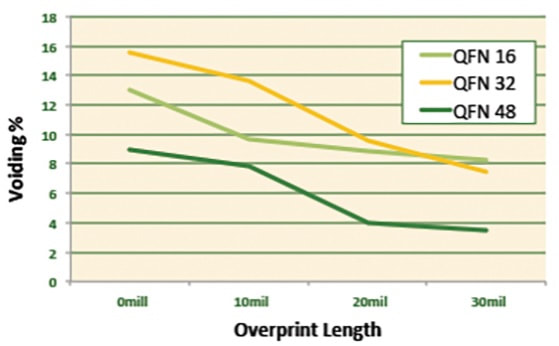Would you believe QFN ground pad voids could be cut by over 50% with a zero-cost, super-simple stencil aperture modification? Not a mod to the ground pad apertures where the voiding is problematic, just to the I/O apertures? Neither did we but after some investigation a method was found by modifying the smaller perimeter apertures. Not an aperture reduction, but a simple overprint at the toe of the pad.
In the experiment we took 3 different MLF devices and applied different toe aperture designs to each. The overprints were measured in simple distances: 0 (1:1 with pad), 10, 20 and 30mil, extending from the toes as seen below. These small overprints should pull back readily in the reflow oven without forming any solder balls, especially with lead-free solder paste.
In the experiment we took 3 different MLF devices and applied different toe aperture designs to each. The overprints were measured in simple distances: 0 (1:1 with pad), 10, 20 and 30mil, extending from the toes as seen below. These small overprints should pull back readily in the reflow oven without forming any solder balls, especially with lead-free solder paste.
The graph below shows the effect of the overprinting on void formation on three different sizes of QFN: 16, 32 and 48 I/O. The drop in voiding is dramatic, and we were astonished at the results.
Voids were consistently reduced by 1/3 or more simply by increasing the volume of solder paste on the I/O pads. The next obvious question is “what is causing these dramatic, repeatable voiding reductions?” Unfortunately, peering inside a convection oven during the reflow process to observe what’s happening, in real-time, on minute solder deposits is not possible. So we have examined the physical evidence and developed a theory on what improved the outgassing during the reflow process.
Our theory is depicted below - We believe that, because the I/Os are on the perimeter, they reach liquidus temperature before the center pad. As they melt, the overprints coalesce onto the I/O pads, lifting the component for a very short period of time – the time between the outside melting and the inside melting. As soon as the print on centerpad melts and wets, the package collapses the solder. We think that momentarily lifting the lid formed by the component enables rapid outgassing and/or the collapse of the component itself forces gas out as it compresses the liquid solder underneath it.
Our theory is depicted below - We believe that, because the I/Os are on the perimeter, they reach liquidus temperature before the center pad. As they melt, the overprints coalesce onto the I/O pads, lifting the component for a very short period of time – the time between the outside melting and the inside melting. As soon as the print on centerpad melts and wets, the package collapses the solder. We think that momentarily lifting the lid formed by the component enables rapid outgassing and/or the collapse of the component itself forces gas out as it compresses the liquid solder underneath it.
In our experiments, the standoff height appeared to be set by the center pad. Different overprint lengths did not substantially affect standoff heights. The extra solder that was printed on the I/O pads migrated to the toes and is visible as darker areas on the X-rays. We created 5760 solder joints in this last run, and didn’t see any bridging or solder balling on any of the devices, even with the 30mil I/O overprint.
We deliberately didn’t do anything fancy on these tests. We used our standard test materials and set up, with a popular Type 4, no-clean SAC305 solder paste, printed with a 4mil (100μm) premium stainless steel stencil with a fluoropolymer nanocoating. A ramp-to-spike, or linear, profile was used. Most void reducing reflow profiles incorporate prolonged thermal exposure or soak zones to promote flux volatilization prior to the alloy reaching liquidus temperatures. The goal of this study was to isolate and assess the efficacy of the I/O paste overprint; therefore we used the least forgiving thermal profile.
The X-ray results were analyzed both visually and with statistical software. Below shows the pictures and the data for the 48 I/O QFN. Seeing is believing and the X-rays offer the most convincing visual evidence that this technique works and works well at void mitigation. The statistics quantify the impact of the I/O overprint on voiding rates, reinforcing the visual images with solid numbers.
We deliberately didn’t do anything fancy on these tests. We used our standard test materials and set up, with a popular Type 4, no-clean SAC305 solder paste, printed with a 4mil (100μm) premium stainless steel stencil with a fluoropolymer nanocoating. A ramp-to-spike, or linear, profile was used. Most void reducing reflow profiles incorporate prolonged thermal exposure or soak zones to promote flux volatilization prior to the alloy reaching liquidus temperatures. The goal of this study was to isolate and assess the efficacy of the I/O paste overprint; therefore we used the least forgiving thermal profile.
The X-ray results were analyzed both visually and with statistical software. Below shows the pictures and the data for the 48 I/O QFN. Seeing is believing and the X-rays offer the most convincing visual evidence that this technique works and works well at void mitigation. The statistics quantify the impact of the I/O overprint on voiding rates, reinforcing the visual images with solid numbers.
So that’s it. No need for costly preforms or elaborate profiles or inert reflow atmospheres. Simply increasing the volume on the I/O pads may hold the key to one of the most effective and easy-to-use voiding remedies – one that provides a significant improvement to arguably the most common frustration on every SMT production floor around the world. And, best of all, IT’S FREE!
|
Return to home page
|





